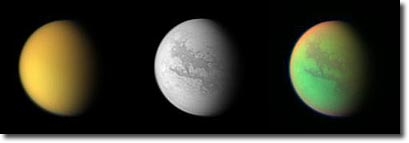Cassini-Huygens observations show how Titan compares with the Earth
LIVERMORE, Calif. — Observations of Titan’s atmosphere offer a unique look at how Saturn’s giant moon compares to Earth.
Titan is the only moon in the solar system with a substantial atmosphere. Like Earth, Titan’s atmosphere is primarily composed of nitrogen, but unlike Earth, one of the most abundant constituents is methane (CH4). Data from the European Space Agency’s Huygens probe, which parachuted through Titan's murky atmosphere in January, will determine if the abundance of argon exceeds that of methane. Methane, the main component in natural gas, plays a key role in the makeup of atmospheric conditions on Titan.
The organic chemistry that occurs in Titan’s atmosphere is an analog of the processes that may have been present in the early terrestrial atmosphere.
The research appears in the May 13 edition of the journal Science.
Using an infrared spectrometer on the international Cassini-Huygens Spacecraft, researchers have measured the temperature, winds and chemical composition of Titan.
Edward Wishnow of Lawrence Livermore National Laboratory participated in the research by measuring the spectrum of methane in the laboratory at temperatures and densities similar to Titan’s – about 113 Kelvin (-256°F) and about one atmosphere pressure. The measurements were performed with a unique spectrometer and cryogenic gas absorption cell in collaboration with H. Gush and I. Ozier at the University of British Columbia and G. Orton at NASA's Jet Propulsion Laboratory.
"Titan’s spectrum shows sharp emission lines that arise due to methane in the stratosphere that is warmer than the underlying denser atmospheric layers," Wishnow said. The correspondence between the lab and Titan spectra is obvious and the strength of the laboratory lines is used to determine the abundance of methane in Titan’s upper atmosphere, he said.
The Cassini Composite Infrared Spectrometer (CIRS) is an infrared instrument that measures the intensity of far-infrared radiation – light with wavelengths between those of radar and near-infrared light. These wavelengths are associated with radiation emission by the constituent gases of Titan’s atmosphere.
Other researchers on the project discovered that Titan exhibits seasonal changes in its stratospheric temperatures and winds that are similar to Earth’s.
"Part of the exhilaration of our scientific exploration comes from understanding how Titan is similar to Earth as well as how it differs," said CIRS principal investigator F. Michael Flasar of NASA/Goddard Space Flight Center. "The CIRS observations of Titan’s stratosphere indicate that its winter (northern) pole has many properties in common with Earth’s: cold temperatures, strong circumpolar winds and anomalous concentrations of several compounds (on Titan, organic molecules) that are reminiscent of conditions within the winter polar regions on Earth, the so-called ozone holes. In both cases the essential ingredient is the strong winds, which isolate the polar air and inhibit mixing with that at lower latitudes."
Founded in 1952, Lawrence Livermore National Laboratory has a mission to ensure national security and apply science and technology to the important issues of our time. Lawrence Livermore National Laboratory is managed by the University of California for the U.S. Department of Energy's National Nuclear Security Administration.
Contact
Anne M. Stark[email protected]
925-422-9799
Related Links
“Intensive Titan Exploration Begins”“Titan’s Atmospheric Temperatures, Winds, and Composition”
Methane found on Saturn playscrucial role in planet formation
Cassini-Huygens Mission to Saturn






